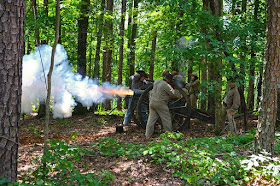 |
| Minie balls found during Camp Douglas dig (Courtesy of Michael Gregory) |
The 34 bankers
boxes are filled with seemingly ordinary items from a Chicago neighborhood that
has seen extraordinary change since its days as home to Camp Douglas, a Federal
training center and prisoner of war camp during the Civil War.
Archaeologist
Michael Gregory plans to further analyze a wide array of these artifacts at his
Milwaukee home. There’s the 1908 license tag for a horse-drawn vehicle, a water
dish for a bird cage, Canadian cheese tubs and a ceramic dust bin.
“It has been
one of the most interesting collections I have ever worked on,” Gregory
recently told the Picket.
Nestled in
those containers are 200 artifacts related to Camp Douglas. About 4,000
Confederates died at the prison, most of whom are buried in a mass grave.
Gregory, formerly associated with DePaul University, has worked with the Camp Douglas Restoration Foundation on a half dozen digs in a corner of the camp.
 |
| (Photo courtesy of Michael Gregory) |
While those
excavations have largely found items produced after the Civil War, experts and
volunteers have recovered Minie balls, a Union cap pin, smoking pipes, a haversack
J-hook, grommets, a spread-eagle button, an 1859 penny (below), and other Camp Douglas
items.
Gregory and
David Keller, head of the foundation, believe they have clearly identified the
camp, though there are significant challenges for urban archaeology.
“The history of the site
shows initial significant development between 1900 and 1915. The property
remained substantially unchanged until 1950, when urban renewal affected the
area,” said Keller. “There remains about 40% of the property that is available
for further study. Alleys and back yards have been identified and offer the
best opportunities.”
The excavations, which
started in October 2013, have taken place on a grassy lot near a school on
Chicago’s South Side. It is in what was the prisoner barracks area in the 60-acre site. The digs have been about 3 feet deep.
 |
| U.S. button (Camp Douglas Restoration Found.) |
Gregory said it’s difficult to know exactly where in the camp
site they are working.
“Our problem
right now is we find something that looks like a ditch between barracks, but we
will find another feature that would be right in the walkway area,” he said.
One eventual aim is to find
a portion of the western stockade wall. “The wall is (elusive)
since we cannot find posts or other evidence,” said Keller. “They are likely
affected by the development of the property. However, the streets are
largely unchanged. This gives us a 30-foot area where the fence might have
been located.”
 |
| Hook for a haversack (Michael Gregory) |
Fetid conditions for the prisoners
The Union facility was
constructed in an area called Douglas, named for Stephen A. Douglas, the famous
Illinois politician.
Camp Douglas originally served as a training facility for Illinois soldiers
being rushed to the front. Much of the site was converted to a prison camp.
About 26,000 Confederates were housed at the camp during the war.
“Had the military been involved (the site) never would have been
selected,” said Keller. “It was noted for its flooding, swampy conditions.”
 |
| Confederate POWs at Camp Douglas (Library of Congress) |
The U.S. Sanitary
Commission, during an inspection, found that the “amount of
standing water, of unpoliced grounds, of foul sinks, of general disorder, of
soil reeking with miasmic accretions, of rotten bones and emptying of camp
kettles … was enough to drive a sanitarian mad.”
It earned well the sobriquet “Andersonville of the North.”
Officials estimate 1 in 7 Confederate prisoners died, although the
exact number is not known. Keller said he believes between 5,000 and 6,000
perished.
 |
| Pipe bowl likely used at camp (Camp Douglas Restoration Found.) |
Area became a 'Black Metropolis'
The prison’s 200 structures went down
when the site was dismantled in December 1865. Camp Douglas largely faded into
history.
What used to be a rural tract just
outside city limits soon became part of Chicago’s rapid growth. A part of
Douglas became known as Bronzeville. It attracted German Jews after the Great Chicago
Fire of 1871. It was home to the Swift family and the Marx Brothers.
But the biggest change was on the
horizon.
Hundreds of thousands of
African-Americans came to Chicago from the South during the Great Migration at
the turn of the 20th century. They wanted a new start after enduring
Jim Crow laws.
 |
| 1908 license tag for horse-drawn vehicle (Michael Gregory) |
While they didn’t get away from
segregation, they were able to establish an area where they have left a cultural,
arts and economic imprint.
“At the Regal Theater on 47th
Street, notable entertainers such as Louis Armstrong and Duke Ellington
performed frequently, and Nat “King” Cole got his start,” according to articles
about the South Side on the website of TV station WTTW. “Other notable
Bronzeville residents included boxer Jack Johnson, gospel legend Mahalia
Jackson, journalist and civil rights activist Ida B. Wells, the writer
Gwendolyn Brooks, and many others.”
The area did run into hard times.
“Following World War II, decades of economic disinvestment
and social change, Bronzeville's luster diminished. Businesses shut their doors
and African-Americans moved further south due to the elimination of restricted
housing covenants,” says a neighborhood council.
 |
| Animal bones found on site (Michael Gregory) |
The recent decades have been kinder, though, according to an October 2014 article in the Chicago
Tribune, crime has remained a problem.
“Today, Bronzeville is experiencing
renewed energy and development, with an emphasis on the arts and a respect for the rich cultural legacy that
Bronzeville has brought to Chicago as a whole,” writes WWTW. It is a center of
African-American enterprise.
There’s been a recent move in Congress
to create the Bronzeville/Black Metropolis National Heritage Area.
Digging in a land of asphalt
Gregory has
worked on all but one excavation outside the John J. Pershing Magnet School for
Humanities on Calumet Avenue. He has studied flood insurance and other maps to
learn more about the neighborhood during and after the Civil War.
 |
| (Wikipedia/public domain) |
The
foundation is trying to obtain National Register for Historic Places status for the
Camp Douglas site, a move it believes should add protection for what’s left. “A
listing is a long shot, but
important step in recognition of the camp,” said Keller. “The process should be
completed early next year.”
While most of the area is
under pavement or has been redeveloped, Gregory said it is important to note
that “even if you had 140 years of development, it doesn’t mean archaeological
resources have been destroyed.”
 |
| Ink well may be from camp (M. Gregory) |
Teams were
able to find a rectangular pit, but Gregory doesn’t know its purpose. A laundry
facility is a possibility. He
said he believes some smoking pipes pieces and bowls may well be associated
with the Civil War. It’s known that one Confederate POW procured or made them
for comrades.
Many camp subsurface
features have been destroyed by development, along with an untold number of
artifacts, since the war. Still, Gregory believes future excavations may find
camp-related ditches and footings.
“We have had
some residents in the area who said they would be happy for us to bring ground
penetrating radar in their yard,” said the archaeologist. “It may provide
little windows” into Camp Douglas’ story.




















